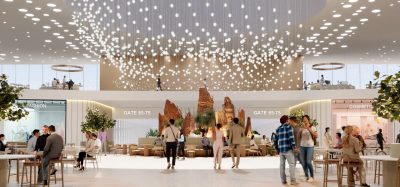RFF station design and siting
Posted: 2 October 2012 | Jack Kreckie, Regulatory Affairs Officer at the Aircraft Rescue and Firefighting Working Group | No comments yet
This is the second part of Jack Kreckie’s article that outlines the requirements of planning a new airport Rescue Firefighting (RFF) station. The first part of this paper was published in International Airport Review Issue 4 2012.
Station layout: The selection of furnishings and equipment should be based on current and anticipated needs, taking into account the next 10 years. Prioritising the value of the space may be required to keep the project within budget limits as there may be items that are good fits for your project and others that are not.
Proximities: As you determine which spaces are necessary, their locations need to be roughly located and the square footage for each of these spaces determined, to work out an initial layout concept. The project team should provide recommended or minimum square foot requirements based on industry standards or requirements. The team needs to have an eye to the future to ensure that there is adequate expansion space to accommodate future growth.
Finishes: Low maintenance should be the general theme in all of the operational spaces in the fire station. The ARFF Subject Matter Expert (SME) should provide questionnaires asking about preferences for finishes in each space.
This is the second part of Jack Kreckie’s article that outlines the requirements of planning a new airport Rescue Firefighting (RFF) station. The first part of this paper was published in International Airport Review Issue 4 2012.
Station layout
The selection of furnishings and equipment should be based on current and anticipated needs, taking into account the next 10 years. Prioritising the value of the space may be required to keep the project within budget limits as there may be items that are good fits for your project and others that are not.
Proximities
As you determine which spaces are necessary, their locations need to be roughly located and the square footage for each of these spaces determined, to work out an initial layout concept. The project team should provide recommended or minimum square foot requirements based on industry standards or requirements. The team needs to have an eye to the future to ensure that there is adequate expansion space to accommodate future growth.
Join us live: Shaping the Next Generation of Hold Baggage and Air Cargo Screening
Join us live for an insightful webinar on 11th December at 14:00 GMT, in collaboration with Smiths Detection, as we explore the strategic balance of operational efficiency, regulatory compliance, and sustainability in high-volume security environments.
This session offers a focused look into future-proofing your security strategy.
Key learning points
- Cost Reduction: Strategies to minimize bag travel time while simultaneously reducing operational costs.
- Regulatory Roadmap: Insights into the next wave of regulatory changes and their impact on future investment decisions.
- Sustainable Systems: Practical approaches to building sustainability into security systems and lowering the total cost of ownership (TCO).
- Scalable Solutions: Real-world examples of scalable systems supporting current airport growth and preparing for tomorrow.
Register now for expert insights, case studies, and actionable strategies on operational efficiency!
Finishes
Low maintenance should be the general theme in all of the operational spaces in the fire station. The ARFF Subject Matter Expert (SME) should provide questionnaires asking about preferences for finishes in each space.
The apparatus room is the most important space in the building. Housing, supporting and maintaining the ARFF appliances are critical to the mission at hand. Office areas/operational spaces are typically shared between duty officers while assigned. Stamped concrete, tile or epoxy sealed floors make great sense in these spaces, as they are easy to maintain and always look good. Training Rooms can be large theater style auditoriums designed to accommodate training for outside agencies, mutual aid responders and in-house training. Dormitories are now often designed as private rooms. The amount of space this adds is the width of the demising walls between each space.
Considerations
Expensive architectural lights in a fire station are not necessary and typically require specialised bulbs. Compact Fluorescent Lights (CFL) bulbs provide up to 75 per cent savings on energy and may be appropriate in certain areas. Finally try to ensure that the light fixtures are located and designed to be serviced without special equipment.
Ergonomics
If a workbench, table or shelf is to be installed, think about its intended use. The height and depth of each may need to be different if the user will be standing, sitting in a chair, or using a high stool. If the space is designed, for example, for the repair of Self Contained Breathing Apparatus (SCBA) and involves the repetition of moving cylinders from a shelf to a bench and back, think about how to minimise the lifting, eliminate obstructions that involve walking around a corner and avoid lifting heavy things above chest height.
Furniture
Furniture should be included in the design and construction budget. This consolidates the cost of the facility, reflecting the actual total cost not just the construction cost. It also puts the burden on the architect to design spaces that accommodate the furnishings necessary to make the room functional. Avoid angled walls in office areas that contribute to awkward angles between furniture and the walls.
Signs
Include signs in the design and construction. This would include exterior signage on the building, in parking areas, on loading docks. It also includes signs outside each room identifying a room number and function e.g. Room 138, Bunkroom. This will be very helpful when a discrepancy is reported in a specific room. If the station has 10 bunkrooms and it is reported that the door hardware in Bunkroom 138 is broken, the maintenance person knows exactly where to go. Signage and the identification system should be uniform throughout the facility.
Agent rapid re-service
If a large scale incident occurs on the airfield or fuel farm, it is not uncommon for an appliance to require an agent rapid re-service i.e. refill water and foam during the incident. Sometimes this can be accomplished in position with tankers, Large Diameter Hose (LDH) lines and foam trailers. There may also be times when the vehicle has to return to quarters to re-supply. The RFF station should have a system to rapidly and safely re-service both foam and water quickly and easily.
A drive-through bay is ideal for a rapid re-service bay. There may not be a guide person available to direct the driver while backing into the bay. Once inside, there should be a LDH pre-connected to a wall hydrant and flaked into a rack. The hose must have the same connection as the largest tank fill inlet on the appliance. The wall hydrant needs to have a drain valve so that after the tank is filled and the hydrant is secured, the LDH can be quickly drained, allowing it to be easily disconnected from the tank fill.
The foam reservoir can be filled from the top or bottom of the vehicle. Filling the tank from the top requires someone to climb up on top of the truck. Introduction of foam from the top usually creates a great deal of suds. The suds overflow from the tank top makes the surrounding area very slippery.
The bottoms of most RFF appliances are fitted with one or two bottom fill connections on the foam reservoir. By filling through the bottom fill connection, there is far less agitation of the foam concentrate. As soon as the entry of foam is covered with foam concentrate, air is excluded and the production of suds stops. This creates a safer situation, as the risk of suds flowing out of the tank creating slippery surfaces is minimised.
The foam re-service system in the station can begin with fixed poly tanks or foam totes. The handling of foam cans and drums is a nuisance, and there is a small amount of foam concentrate left in the can and wasted every time. With the cost of foam, waste should be minimised. A foam pump system can be tied into a storage tank or tote. The system can be tied into a hard rubber line with a fitting to connect to the foam reservoir bottom fill connection. Foam piping in the system should be PVC. Foam is very slippery and under pressure will find its way through pipe threads of threaded pipe. By including a suction inlet on the foam pump, it can be used to draw foam out of a tank for repairs or service. A spare tote should always be available to store foam that was drawn out of a vehicle foam reservoir required for tank repair or maintenance.
Phase 3: Final design
There will be a number of submissions during the final design period. The final floor plan/ layout starts gathering detail. The drawings now reach into various levels, providing civil work, i.e. geo-technical surveys, foundation, utilities, and elevations. There will be drawings for electrical, plumbing, Heating Ventilation and Air Conditioning (HVAC) etc. There may be five or six submissions before the plans are 100 per cent complete and approved. These drawings and the written specifications need to be reviewed by the RFF representative on the team. Any errors found before the approved final design are just corrections, whereas a change called for after the construction has begun is a ‘change order’ and has a direct cost associated for time and materials. If the change interrupts another scheduled construction activity, charges can be assessed for that interruption, and in extreme situations, even cause a change in the completion date, which adds to the cost of maintaining operating conditions during construction.
Codes/requirements
Building design and construction are driven by codes or laws that provide minimum standards for every element of construction. Some areas may have more stringent codes than others, often driven by regional conditions. For example, a project in an earthquake zone will have more stringent requirements to withstand the effects of an earthquake. Many projects are simple in that they follow one set of codes. A residence comes with a set of construction codes that dictates the structural minimal requirements, as well as electrical service, plumbing, sewage or septic, etc. A fire station overlaps into multiple types of codes.
The garage area, wherein rescue equipment is parked, falls into a garage code. It will require a different floor load, and also to be separate from the living areas, due to exhaust, fuel, storage, etc. The garage area actually becomes a separate structure attached to the station.
A large fire station kitchen equipped with commercial appliances may be required to satisfy the standards for a commercial kitchen in a restaurant. This includes fire detection and suppression in the exhaust hood. A strong recommendation would be to install a master disconnect for the cooking appliances so the switch can be hit on the way out the door, thereby reducing the opportunity for a kitchen fire in the fire station when an emergency response is received during meal preparation.
Fire station dormitories do not usually have their own code, but dormitory codes for prisons and schools are considered commercial space. Firefighters think of a bunkroom like a bedroom in a residential space. Most residential codes require an electrical outlet every five feet. A commercial code may require only half that number. In this age where everything needs to be charged, the demand for plugs in a bunkroom is increasing rather than decreasing. Attention to detail in the plan review will identify those needs early and minimise the impact on the project.
Life safety codes vs. emergency response requirements
Conflicts regarding door swing direction and locked doors are always a problem at airports. Life safety codes require that any area of public assembly has enough exit doors for the size and design of the space and the number of people authorised for occupancy. The exit doors must be clearly marked, equipped with panic hardware, and open without obstruction with minimal force. This becomes problematic in an airport terminal, as security regulations require the secure airport operations area to be inaccessible to nonbadged personnel. The fire station may share part of that problem in that certain areas may be designed for access and public use yet cannot provide access to the secure airfield. In addition, there are issues where life safety codes interfere with the direction of travel for emergency responders reacting to an emergency. For example, the garage is seen as this space with fuel, chemicals, equipment and noise. The size of the space requires exits on either side (front and back). The exit doors used to escape the garage would need to open into the living areas of the fire station. For response purposes, those doors must swing into the garage to minimise interruptions in response or injuries from a door moving in the wrong direction.
Phase 4: Construction
All the time invested by the RFF team during design will no doubt provide for a smoother construction period, but the work is not over. Drawings and specifications are designed to provide all of the specific detail and coordination for a complex construction project. In reality, they are never perfect. Decisions are made during the construction process to fill the voids or satisfy a need not considered in planning. If the fire department is not present during construction meetings and walkthrough tours, the decisions will be made without their input. That is never in the best interest of the fire department. Involvement in this important process is from start to finish.
Final inspection/punch list
The contractors will be pushing for a date when the final inspection and acceptance can be conducted. There is typically a large payment due at that point so they are highly motivated. The construction managers will develop a punch list of issues needing correction. There will be many items. The fire department needs to conduct a detailed inspection of every space, system, drain, and detail. Once the building is accepted and occupied, it is very difficult to get the contractor to correct these items. Avoid occupancy as long as possible, striving to get 100 per cent corrections for the punch-list items. This will not be a popular decision, as everyone is anxious to move into the new facility. Once occupancy occurs, leverage is gone, and you will live with the punch-list items or correct them internally.
Conclusion
The considerations of RFF station siting and design cannot all be included in one article. The intention of this piece is to stimulate the thought process, provide some opportunities to gather resources, and raise some specific points from lessons learned that may positively contribute to such a project. As always, networking is a valuable tool. Counterparts and colleagues around the world are anxious to offer advice, guidance and experience. Ensure that the right design team is in place and that they truly understand the mission, goals, image and needs of the RFF department.
Join our free webinar: Beyond silos: How ecosystem thinking elevates the airport experience
In today’s complex aviation landscape, airports are moving beyond siloed operations to embrace a new era of collaboration. This webinar focuses on how leading airports are using ecosystem thinking to adapt, personalize, and continuously improve every touchpoint, boosting both passenger satisfaction and non-aeronautical revenue.
Date: 13 Nov | Time: 10:00 GMT
REGISTER NOW TO SECURE YOUR SPOT
Can’t attend live? No worries – register to receive the recording post-event.


















